Werckmeister Harmonies (Bela Tarr) 2001
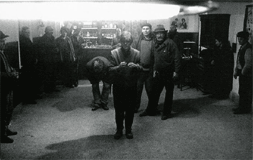 Hungarian director Bela Tarr’s Werckmeister Harmonies
begins with the image of a flame being doused out. This is significant, because
in this political drama, the conflict between light and dark provides much of
the thematic fodder. In an astonishing opening scene, the camera smoothly zooms
and pans around a dilapidated pub, as János, the film’s hero and an amateur
astronomer, uses his drunken compatriots to demonstrate a solar eclipse.
Although Tarr never cuts here, he manages to show close-ups, varying angles, and
establishing shots by elegantly transitioning from one to another. His 1994
masterpiece Satantango was technically accomplished, but not quite so
polished as this film is. The credits list six cinematographers (the film was
shot, like Satantango, over four years) but there is a unified look to
the film that is breathtaking. When János leaves the pub, into the darkness
that waits outside, we sit absolutely dazzled.
Hungarian director Bela Tarr’s Werckmeister Harmonies
begins with the image of a flame being doused out. This is significant, because
in this political drama, the conflict between light and dark provides much of
the thematic fodder. In an astonishing opening scene, the camera smoothly zooms
and pans around a dilapidated pub, as János, the film’s hero and an amateur
astronomer, uses his drunken compatriots to demonstrate a solar eclipse.
Although Tarr never cuts here, he manages to show close-ups, varying angles, and
establishing shots by elegantly transitioning from one to another. His 1994
masterpiece Satantango was technically accomplished, but not quite so
polished as this film is. The credits list six cinematographers (the film was
shot, like Satantango, over four years) but there is a unified look to
the film that is breathtaking. When János leaves the pub, into the darkness
that waits outside, we sit absolutely dazzled.
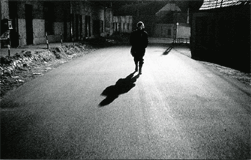 The rest of the film doesn’t quite live up to the majesty
of this opening sequence, but it hardly falters either. The plot follows János
as he interfaces with his family members and watches the town around him grow
steadily uneasy at the prospect of a sideshow attraction coming to their town.
Similarly to his Satantango, Tarr uses the solemn intoning of the church
bells to suggest to forthcoming apocalypse. The townspeople aren’t so much
xenophobic as wearied by the inevitable prospect of yet another revolution.
Rumors of the destruction it brings travel faster than the sideshow itself, and
as such the villagers are “sure that something is to come”, and feel its
suffocating presence looming on the horizon as surely as a farmer can feel the
oncoming rain. When the massive truck carrying the giant whale that is the
sideshow’s main attraction arrives, it seems to dwarf the town, stopping the
light from reaching anything that it passes by.
The rest of the film doesn’t quite live up to the majesty
of this opening sequence, but it hardly falters either. The plot follows János
as he interfaces with his family members and watches the town around him grow
steadily uneasy at the prospect of a sideshow attraction coming to their town.
Similarly to his Satantango, Tarr uses the solemn intoning of the church
bells to suggest to forthcoming apocalypse. The townspeople aren’t so much
xenophobic as wearied by the inevitable prospect of yet another revolution.
Rumors of the destruction it brings travel faster than the sideshow itself, and
as such the villagers are “sure that something is to come”, and feel its
suffocating presence looming on the horizon as surely as a farmer can feel the
oncoming rain. When the massive truck carrying the giant whale that is the
sideshow’s main attraction arrives, it seems to dwarf the town, stopping the
light from reaching anything that it passes by.
Charged by his Aunt Tünde, who is shacking up with the
chief of police, to spy on the surroundings in the town square that the
attraction sets up in, János goes to see the whale, which resides in the Town
Square. As the mammoth case containing the beast opens, a flock of birds flies
away, suggesting what lies inside is distinctly unnatural. János finds the
giant beast a wonder of nature and a fluke on the evolutionary scale, even
though the other townspeople regard it suspiciously, viewing its existence as a
“test of faith.” The Prince, an
advertised side-attraction, rumored to be born with three eyes and standing
three feet tall, is nowhere to be found in the dark trailer, however.
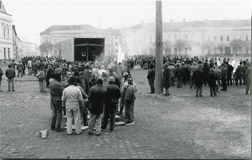 The film’s title gains meaning when János overhears his
uncle György, a cooped-up music theorist, talk about tonal scales. He explains
that the Werckmeister scale, upon which the musical octave is based, is a false
construct, and is not true to natural sound since it cannot convey the full
range possible in nature. He elaborates, stating that since all music is based
on this faulty foundation, it is all inherently false. With his description of
these musical concepts, György seems to tap into the film’s undercurrents.
Certainly, the defective musical scale is roughly analogous to the broken
political state of the country that the film is set in. His suggestion that all
music is unnatural seems to set up a competition between the natural and
unnatural (light and dark) that runs throughout the work. That he’s driven his
wife Tünde out of his house with his obsession toward his out of tune piano
doesn’t bother him in the least.
The film’s title gains meaning when János overhears his
uncle György, a cooped-up music theorist, talk about tonal scales. He explains
that the Werckmeister scale, upon which the musical octave is based, is a false
construct, and is not true to natural sound since it cannot convey the full
range possible in nature. He elaborates, stating that since all music is based
on this faulty foundation, it is all inherently false. With his description of
these musical concepts, György seems to tap into the film’s undercurrents.
Certainly, the defective musical scale is roughly analogous to the broken
political state of the country that the film is set in. His suggestion that all
music is unnatural seems to set up a competition between the natural and
unnatural (light and dark) that runs throughout the work. That he’s driven his
wife Tünde out of his house with his obsession toward his out of tune piano
doesn’t bother him in the least.
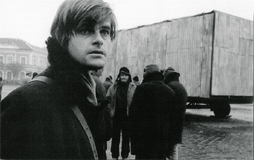 Tünde feels differently, however. She threatens to move
back in with her husband if he doesn’t support her “Clean Town Movement”,
an organization she’s devised with the town’s police chief to rid the area
of the vagrants that the sideshow has attracted. He uses his influence to
collect money to support her cause, despite her flagrant infidelity. That the
town is filled with the rumors of civil unrest and chaos in the Square increases
their willingness to contribute to the fund. That they can’t be bothered to
investigate the rumors themselves (“Being careful never hurt anybody,” says
one) is perhaps the harshest indictment of their indifference.
Tünde feels differently, however. She threatens to move
back in with her husband if he doesn’t support her “Clean Town Movement”,
an organization she’s devised with the town’s police chief to rid the area
of the vagrants that the sideshow has attracted. He uses his influence to
collect money to support her cause, despite her flagrant infidelity. That the
town is filled with the rumors of civil unrest and chaos in the Square increases
their willingness to contribute to the fund. That they can’t be bothered to
investigate the rumors themselves (“Being careful never hurt anybody,” says
one) is perhaps the harshest indictment of their indifference.
Tünde celebrates her success by dancing with the police
chief as he waves his gun in the air callously and by ordering János, who we
see as a fire stoker, suggesting he sees the true nature of things, to look
after the chief’s children. The children are shown with disdain, mimicking
their elder’s taste for discordant music and war toys. It’s downright
frightening the way that one boy is shown defiantly attacking János and
repeatedly bellowing, “I’ll be hard on you!” into a fan, distorting his
voice into something that must surely sound closer to his father’s.
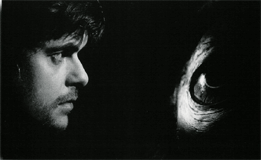 When János returns to the Square, he finds a veritable
cult has gathered around the attraction. After sneaking into the truck where the
whale is stored, he overhears a disturbing tirade from The Prince. “What they
build and what they will build is illusion and lies. What they think and what
they will think is ridiculous,” he says in his mechanical voice. He continues,
saying that he likes things that fall apart, seeing “construction in the
ruins.” It’s a veritable call for the destruction of the town, but it’s
notable that János flees before we hear it delivered to its proper audience.
Instead, Tarr shows us a shot of János running away in the night until he
realizes that the insurgents have set the town aflame. The implication here is
that we don’t know exactly what caused the riot to break out. It could have
been the result of The Prince’s speech, but it also could have been the result
of Tünde’s plotting, or the bursting of the millennial tension that had
gripped the town.
When János returns to the Square, he finds a veritable
cult has gathered around the attraction. After sneaking into the truck where the
whale is stored, he overhears a disturbing tirade from The Prince. “What they
build and what they will build is illusion and lies. What they think and what
they will think is ridiculous,” he says in his mechanical voice. He continues,
saying that he likes things that fall apart, seeing “construction in the
ruins.” It’s a veritable call for the destruction of the town, but it’s
notable that János flees before we hear it delivered to its proper audience.
Instead, Tarr shows us a shot of János running away in the night until he
realizes that the insurgents have set the town aflame. The implication here is
that we don’t know exactly what caused the riot to break out. It could have
been the result of The Prince’s speech, but it also could have been the result
of Tünde’s plotting, or the bursting of the millennial tension that had
gripped the town.
Whatever the cause, the result is the same. The unnatural
presence of The Prince and the whale seems to seep into the people as they begin
to tear the town apart. Tarr shows us only the destruction of one building, but
the impressionistic and highly stylized way that he shows it (using
choreographed moves and a tracking shot so that we can connect all of the damage
that we see) suggests that these same events have occurred everywhere. When Tarr
trots out a powerful image that makes the men literally see the light, the group
mentality folds as quickly as it had sprung up, causing an embarrassed retreat.
János, the witness to all of this destruction is moved stunned by it, and
ironically implicated in it (made doubly ironic by the fact that he was actually
a spy for his technically law-abiding aunt). When we see Tünde again, the film
seems to suggest that she has gained power from this uprising, despite her
detestable behavior. In an angry bit of rhetoric, Tarr punishes all who
attempted to see things as they really were, and next to last moment, which
shows the roles of caregiver and receiver of care switch once again harshly
suggests this is a cycle doomed to repeat. At the film’s end, the beached
whale remains in the Town Square, a monument to the unnatural occurrence of a
political uprising born from a broken system.
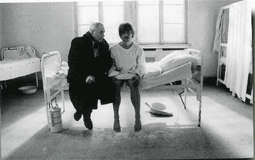 Tarr tells his tale with a stunning amount of economy.
Instead of a clutter of metaphors, he opts for a few, and exploits them fully
both visually and textually. The questions asked by the film are far more
universal than they might originally appear and are unlikely to shrink in
relevance. The only questionable moments in the film come when Tarr uses a score
to underline his emotional impact. Since the film argues all music is inherently
false, the score seems to be used ironically, at best (unless I am just tone
deaf and it was meant to come from György’s specially tuned piano). In any
case, Werckmeister Harmonies is a more accessible, less rambling work
than Tarr’s Satantango, and if it’s ultimately not quite as
encompassing, because of its technical prowess and its thematic conciseness it
certainly deserves equal amounts of esteem.
Tarr tells his tale with a stunning amount of economy.
Instead of a clutter of metaphors, he opts for a few, and exploits them fully
both visually and textually. The questions asked by the film are far more
universal than they might originally appear and are unlikely to shrink in
relevance. The only questionable moments in the film come when Tarr uses a score
to underline his emotional impact. Since the film argues all music is inherently
false, the score seems to be used ironically, at best (unless I am just tone
deaf and it was meant to come from György’s specially tuned piano). In any
case, Werckmeister Harmonies is a more accessible, less rambling work
than Tarr’s Satantango, and if it’s ultimately not quite as
encompassing, because of its technical prowess and its thematic conciseness it
certainly deserves equal amounts of esteem.
**** Masterpiece
01-24-02
Jeremy Heilman